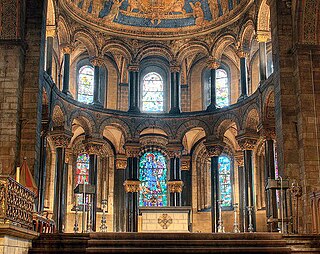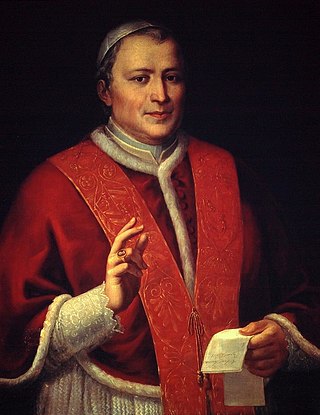History
Historically, today's territory of the Diocese of Aachen belonged to the Diocese of Liège and the Archdiocese of Cologne. The diocese was first created in 1802, covering the area west of the Rhine formerly belonging to Cologne, as well as parts from the dioceses Liège, Utrecht, Roermond and Mainz. After the first bishop Marc Antoine Berdolet died in 1809, Pope Pius VII refused to commission the successor suggested by Napoleon, Jean Denis François Camus. After the French rulership over the area, the diocese was abolished by the bull De salute animarum of July 16, 1821, and incorporated into the archdiocese of Cologne.
On August 13, 1930 the diocese was re-established by the papal bull Pastorale officii nostri. Joseph Vogt was appointed as its first bishop.

The Latin Patriarchate of Jerusalem is the Latin Catholic ecclesiastical patriarchate in Jerusalem, officially seated in the Church of the Holy Sepulchre. It was originally established in 1099, with the Kingdom of Jerusalem encompassing the territories in the Holy Land newly conquered by the First Crusade. From 1374 to 1847 it was a titular see, with the patriarchs of Jerusalem being based at the Basilica di San Lorenzo fuori le Mura in Rome. Pope Pius IX re-established a resident Latin patriarch in 1847.

The Diocese of Las Cruces is the Latin Church ecclesiastical territory or diocese of the Catholic Church in southern New Mexico in the United States. It is a suffragan diocese in the ecclesiastical province of the metropolitan Archdiocese of Santa Fe.

The Archdiocese of Manila is the archdiocese of the Latin Church of the Catholic Church in Metro Manila, Philippines, encompassing the cities of Manila, Makati, San Juan, Mandaluyong, Pasay, Taguig, and Quezon City. Its cathedral is the Minor Basilica and Metropolitan Cathedral of the Immaculate Conception, also known as the Manila Cathedral, located in Intramuros, which comprises the old city of Manila. The Blessed Virgin Mary, under the title Immaculate Conception, is the principal patroness of the archdiocese.

The Diocese of Roermond is a diocese of the Latin Church of the Catholic Church, located in the Netherlands. The diocese is one of the seven suffragan dioceses in the ecclesiastical province of the Metropolitan Archbishop of Utrecht. The territory of the diocese covers the Province of Limburg.

Mosan art is a regional style of art from the valley of the Meuse in present-day Belgium, the Netherlands, and Germany. Although in a broader sense the term applies to art from this region from all periods, it generally refers to Romanesque art, with Mosan Romanesque architecture, stone carving, metalwork, enamelling and manuscript illumination reaching a high level of development during the 11th, 12th and 13th centuries.
A doctor of both laws, from the Latin doctor utriusque juris, juris utriusque doctor, or doctor juris utriusque, is a scholar who has acquired a doctorate in both civil and church law. The degree was common among Roman Catholic and German scholars of the Middle Ages and early modern times. Today the degree is awarded by the Pontifical Lateran University after a period of six years of study, by the University of Würzburg, and by the University of Fribourg, as well as the University of Cologne.

The Metropolitan Archdiocese of Paderborn is a Latin Church archdiocese of the Catholic Church in Germany; its seat is Paderborn. It was a diocese from its foundation in 799 until 1802, and again from 1821 until 1930. In 1930, it was promoted to an archdiocese. From 1281 until 1802, the Bishopric of Paderborn was also a state of the Holy Roman Empire.

The Archdiocese of Berlin is a Latin Church ecclesiastical territory or archdiocese of the Catholic Church in Germany. The archepiscopal see is in Berlin, with the archdiocese's territory extending over Northeast Germany.

In the Catholic Church, a bishop is an ordained minister who holds the fullness of the sacrament of holy orders and is responsible for teaching doctrine, governing Catholics in his jurisdiction, sanctifying the world and representing the Church. Catholics trace the origins of the office of bishop to the apostles, who it is believed were endowed with a special charism and office by the Holy Spirit at Pentecost. Catholics believe this special charism and office has been transmitted through an unbroken succession of bishops by the laying on of hands in the sacrament of holy orders.

The Diocese of Namur is a Latin Church ecclesiastical territory or diocese of the Catholic Church in Belgium. It is a suffragan of the Archdiocese of Mechelen-Brussels. The diocese is a suffragan in the ecclesiastical province in the metropolitan Archdiocese of Mechelen-Brussels. Its cathedra is found within St. Aubin's Cathedral in the episcopal see of Namur.

The Roman Catholic Metropolitan Archdiocese of Kuala Lumpur is an ecclesiastical territory or diocese of the Roman Catholic Church in Malaysia. It was erected as the Diocese of Kuala Lumpur by Pope Pius XII on 25 February 1955, and was elevated to the rank of a Metropolitan Archdiocese on 18 December 1972, with the suffragan sees of Malacca-Johor and Penang. It also administers the capital city of Malaysia, Federal Territory of Kuala Lumpur as well as the federal administrative centre of Putrajaya and the urbanised states of Selangor and Negeri Sembilan in the central region as well as Pahang and Terengganu on the East Coast. The archdiocese's Mother Church and thus, seat of its Archbishop, is St. John's Cathedral. It was one of the three Roman Catholic archdioceses in Malaysia, with the ecclesiastical archdioceses of Kota Kinabalu and Kuching, both at the Borneo Islands.

The Diocese of Rožňava is a Latin Church diocese of the Catholic Church in southern Slovakia. It covers central and eastern parts of the Banská Bystrica Region and western parts of the Košice Region. Its seat is in Rožňava, covers an area of 7,000 km2 with 343,352 people of which 58% are of Catholic faith (2004).

The Roman Catholic Metropolitan Archdiocese of Olomouc is a metropolitan archdiocese of the Latin Church of the Catholic Church in the Czech Republic. It has its seat in Olomouc.
San Giovanni Profiamma is a civil parish in the municipality of Foligno in the province of Perugia, which is also an active bishopric, and is the historical site of the former Roman town and bishopric of Foro Flaminii, which remains a Latin Catholic titular see as Foro Flaminio. It is in the circoscrizione no. 6: San Giovanni Profiamma-Belfiore-Vescia-Capodacqua-Pontecentesimo.

The Archdiocese of Gdańsk is a Latin Church ecclesiastical jurisdiction or archdiocese of the Catholic Church in Poland. The diocese's episcopal see is Gdańsk.

The Diocese of Limburg is a Latin Church diocese of the Catholic Church in Germany. It belongs to the ecclesiastical province of Cologne, with metropolitan see being the Archdiocese of Cologne.

The Diocese of Liège is a Latin Church ecclesiastical territory or diocese of the Catholic Church in Belgium. The diocese was erected in the 4th century and presently covers the same territory as Belgium's Liège Province, but it was historically much larger. Currently, the diocese is a suffragan in the ecclesiastical province of the Archdiocese of Mechelen-Brussels. Its cathedra is found within St. Paul's Cathedral in the episcopal see of Liège.

The diocese of Eupen-Malmedy is a former Belgian Latin Roman Catholic diocese, which existed between 1919 and 1925, and included the East Cantons.

On 4 March 1853, Pope Pius IX restored the episcopal hierarchy in the Netherlands with the papal bull Ex qua die arcano, after the Dutch Constitutional Reform of 1848 had made this possible. The re-establishment of the episcopal hierarchy led to the April movement protest in 1853.



















